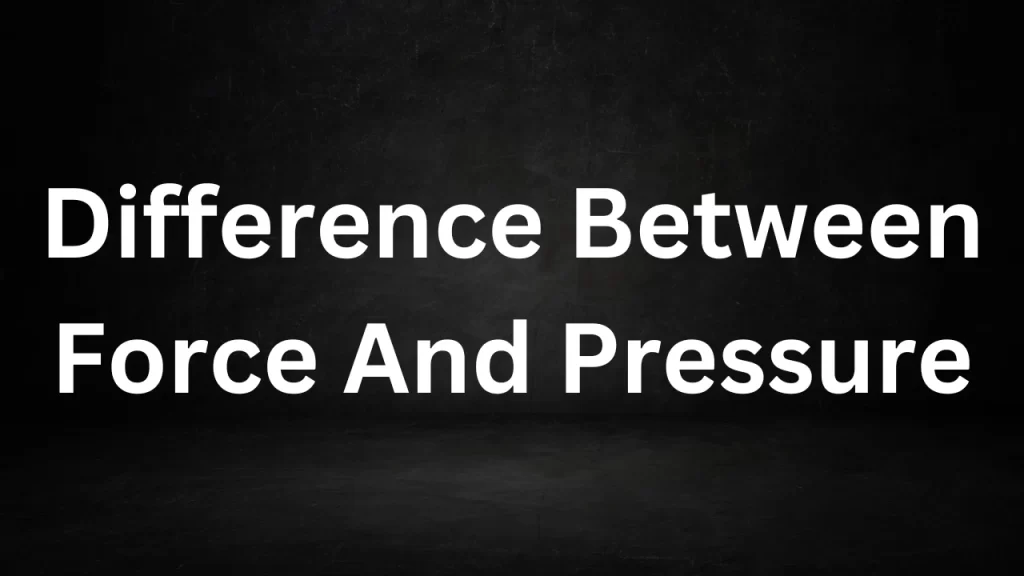Tag: force of pneumatic cylinder
Difference Between Force And Pressure
Difference Between Force And Pressure: Significant disparities exist between force and pressure, despite both being fundamental concepts in physics. To grasp this contrast, it’s essential to comprehend their definitions and applications.

Force involves push and pull actions leading to alterations in motion and direction, while pressure quantifies the physical force distributed over a specific area.
Definition:
Force: Force is a vector quantity that represents a push or pull exerted on an object due to its interaction with another object. It has both magnitude and direction and is measured in newtons (N).
Pressure: Pressure is a scalar quantity that measures the intensity of a force applied to a specific area. It is the force per unit area and is expressed in units such as pascals (Pa) or pounds per square inch (psi).
Nature:
Force: Force is a fundamental concept in physics and can manifest as a push or pull along a straight line or at an angle. It acts on a specific point or object and can result in motion or deformation.
Pressure: Pressure is the distribution of force over a given area. It doesn’t act on a specific point but rather is spread out uniformly over the surface. It describes how force is distributed over an area.
Vector vs. Scalar:
Force: Force is a vector quantity because it has both magnitude and direction. It is represented by an arrow indicating the direction of the push or pull.
Pressure: Pressure is a scalar quantity as it has magnitude only. It does not have a specific direction associated with it.
Units:
Force: Force is measured in newtons (N) in the International System of Units (SI) and can also be expressed in other units like pounds or dynes.
Pressure: Pressure is measured in pascals (Pa) in SI units. In other systems, it can be measured in pounds per square inch (psi) or atmospheres (atm).
Formula:
Force: The formula for force is F = ma, where F represents force, m is mass, and a is acceleration. It can also be calculated as the rate of change of momentum, F = Δp/Δt.
Pressure: Pressure is calculated using the formula P = F/A, where P represents pressure, F is the force applied, and A is the area over which the force is distributed.
Effect on Objects:
Force: A force can result in the motion of an object or changes in its shape or velocity. It can cause acceleration or deformation.
Pressure: Pressure affects the deformation of an object or the behavior of fluids (liquids and gases) within containers. It does not necessarily cause motion but can lead to changes in the state or shape of matter.
Examples:
Force: Examples of forces include lifting a book, pushing a car, or pulling an object with a rope.
Pressure: Examples of pressure include the pressure exerted by a gas in a closed container, atmospheric pressure on Earth’s surface, and the pressure applied by a thumbtack on a bulletin board.
In summary, force is a vector quantity representing a push or pull with magnitude and direction, while pressure is a scalar quantity representing the distribution of force over a specific area.
Read More
- Class 10 Geography Book NCERT PDF in English Download
- 10th Class History Textbook PDF English Medium NCERT Download
- Class 10 Social Science Book Pdf Download In Hindi
- NCERT Political Science Class 10 Pdf Download In Hindi
- NCERT Books For Class 10 Economics In Hindi Medium PDF
Frequently Asked Question (FAQs)
What is the fundamental difference between force and pressure?
The fundamental difference lies in their nature. Force is a vector quantity with both magnitude and direction, representing a push or pull on an object. Pressure, on the other hand, is a scalar quantity that measures the intensity of force distributed over an area.
How is force measured?
Force is typically measured in newtons (N) in the International System of Units (SI). It can also be expressed in other units like pounds or dynes.
What are some real-world examples of force?
Examples of forces include lifting objects, pushing or pulling a car, gravitational forces, and tension in ropes or cables.
How is pressure calculated?
Pressure is calculated using the formula P = F/A, where P represents pressure, F is the force applied, and A is the area over which the force is distributed.
Is pressure a vector or scalar quantity?
Pressure is a scalar quantity, as it has magnitude but does not have a specific direction associated with it.